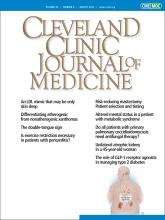Article Figures & Data
Tables
Drug Available doses Frequency and route Dose approved for weight management Exenatide 5 μg, 10 μg Twice daily subcutaneously Not approved Liraglutide 0.6 mg, 1.2 mg, 1.8 mg Once daily subcutaneously 0.6 mg once daily for 1 week, increase by 0.6 mg daily at weekly intervals to a target dose of 3 mg once daily Exenatide extended-release 2 mg Once weekly subcutaneously Not approved Dulaglutide 0.75 mg, 1.5 mg, 3 mg, 4.5 mg Once weekly subcutaneously Not approved Semaglutide 0.25 mg, 0.5 mg, 1 mg, 2 mg Once weekly Titrate every 4 weeks: 0.25 mg, 0.5 mg, 1 mg, 1.7 mg, 2.4 mg once weekly Semaglutide, oral 3 mg, 7 mg, 14 mg Once daily by mouth Not approved Liraglutideinsulin degludec 0.36 mg-10 U 0.5 mg-16 U Once daily subcutaneously Not approved Lixisenatideinsulin glargine 5 μg-15 U 10 μg-30 U Once daily subcutaneously Not approved Tirzepatide 2.5 mg, 5 mg, 7.5 mg, 10 mg, 12.5 mg, 15 mg Once weekly subcutaneously Not approved - TABLE 2
Effects of glucagon-like peptide-1 receptor agonistson major adverse cardiovascular events in clinical trials
Trial Number of patients Median follow-up Cardiovascular disease at baselinea Treatment Number needed to treatb REWIND15 9,901 5.4 years 31.5% Dulaglutide 1.5 mg subcutaneously weekly 323 SUSTAIN-616 3,297 2.1 years 2.1 years 60.5% Semaglutide 0.5 or 1 mg subcutaneously weekly 83 LEADER17 9,340 3.8 years 81.3% Liraglutide 1.6 mg subcutaneously daily 200 ELIXA18 6,068 2.1 years 100% Lixisenatide 10 or 20 μg subcutaneously daily No benefit EXSCEL19 14,752 3.2 years 70% Exenatide extended-release 2 mg subcutaneously weekly No benefit PIONEER-621 3,183 1.3 years 85% Semaglutide 14 mg by mouth daily No benefit ↵a All patients had longstanding type 2 diabetes and also either had a history of cardiovascular disease or were at risk of it.
↵b Number of patients needed to be treated for 1 year to prevent 1 major adverse cardiovascular event (myocardial infarction, stroke, or death from cardiovascular causes, plus, in the ELIXA trial, hospitalization for heart failure), calculated as the inverse of the absolute risk reduction.
ELIXA = Lixisenatide in Patients With Type 2 Diabetes and Acute Coronary Syndrome; EXSCEL = Effects of Once-Weekly Exenatide on Cardiovascular Outcomes in Type 2 Diabetes; LEADER = Liraglutide Effect and Action in Diabetes: Evaluation of Cardiovascular Outcome Results; PIONEER-6 = Oral Semaglutide and Cardiovascular Outcomes in Patients With Type 2 Diabetes; REWIND = Researching Cardiovascular Events With a Weekly Incretin in Diabetes; SUSTAIN-6 = Semaglutide and Cardiovascular Outcomes in Patients With Type 2 Diabetes






